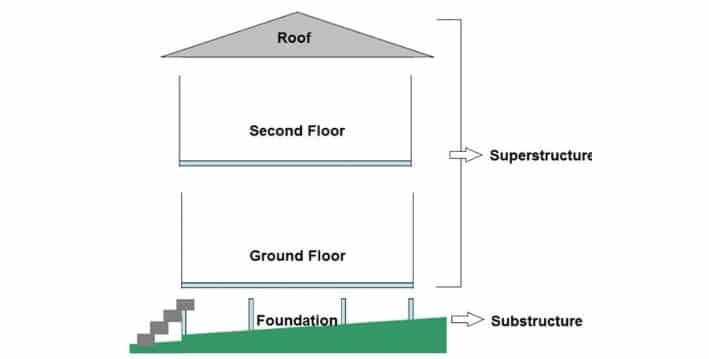🕑 Reading time: 1 minute
In the world of construction, building projects are delineated into two fundamental components: substructure and superstructure. Each plays a crucial role in the structural integrity and functionality of the edifice.
Superstructure
The superstructure encompasses the portion of a building erected above ground level. Serving the primary purpose of facilitating the intended use of the structure, it comprises an array of elements. These include:
- Columns: Vertical load-bearing members designed to support the weight of the structure above.
- Beams: Horizontal members that distribute the load imparted by the superstructure evenly across supporting columns or walls.
- Slabs: Flat, horizontal surfaces integral to the floors or ceilings of a building.
- Finishes: Materials applied to surfaces for aesthetic or protective purposes, such as paint or cladding.
- Door and Window Schedules: Detailed plans outlining the placement, dimensions, and specifications of doors and windows.
- Flooring: Surface materials covering the ground-level areas of a building.
- Roofing: The structure and materials composing the overhead covering of a building.
- Lintels: Horizontal supports spanning openings such as doors and windows.
- Parapets: Low protective walls or barriers at the edge of a roof or balcony.

Substructure
Contrastingly, the substructure constitutes the foundational support system constructed beneath ground level. Its primary function is to transfer loads from the superstructure to the underlying soil, necessitating direct contact with the supporting terrain. Key elements of the substructure encompass:
- Footings: Structural components that distribute the load from the superstructure to the soil beneath, ensuring stability and preventing settlement.
- Plinth: The base or platform upon which the superstructure is erected, serving as a transition between the foundation and the building proper.
Roles of Structural Engineers
The meticulous planning and execution of both substructure and superstructure fall under the purview of structural engineers, who play a pivotal role in ensuring the safety and integrity of the building project. Responsibilities of structural engineers include:
- Generating comprehensive plans and specifications for the substructure, accounting for factors such as soil conditions, building requirements, and local regulations.
- Calculating stresses and loads to determine the structural requirements of the building, ensuring it can withstand anticipated forces and environmental conditions.
- Incorporating support beams, columns, and foundations into substructure plans, meticulously designing each element to fulfill its intended function and uphold the stability of the edifice.
Table-1 Differences between superstructure and substructure of a building
| Superstructure | Substructure | |
| Location | Constructed above ground level | Constructed below ground level |
| Purpose | Facilitates building’s intended use | Transfers loads to supporting soil |
| Elements | Walls, columns, beams, doors, windows, etc. | Foundations, plinth |
In essence, the harmonious integration of substructure and superstructure forms the bedrock of any building project, epitomizing the meticulous coordination and expertise of structural engineering. By comprehensively delineating each component’s function and significance, stakeholders can navigate the complexities of construction with clarity and precision.
